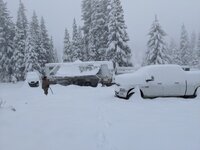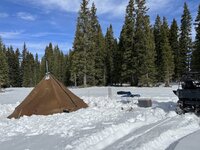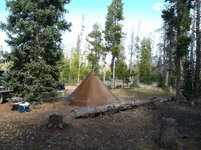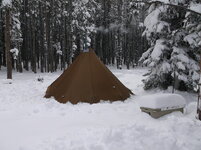Navigation
Install the app
How to install the app on iOS
Follow along with the video below to see how to install our site as a web app on your home screen.
Note: This feature may not be available in some browsers.
More options
Style variation
You are using an out of date browser. It may not display this or other websites correctly.
You should upgrade or use an alternative browser.
You should upgrade or use an alternative browser.
Second season Colorado gear suggestions
- Thread starter cgill54
- Start date
When I lived in Co we typically started ice climbing season in september. At the same time, we routinely were rock climbing in t shirts through mid-winter. All dependent on amount of sun vs shade, and elevation. Freak weather may not be likely per se (although should not come as any surprise with 10,000’ of relief in the neighborhood) but you can absolutely bank on a significantly wider range of temperatures than most people who dont live in a similar area are used to seeing. Perfect weather forecast with temps in the 70’s, Id still bring a rain jacket and a decently thick down jacket. It’s like having a spare tire in your car, most trips you dont need it but that one time you do you are guaranteed to be in a hurry for something important.
Here in CO the weather changes all the time. If you have an inreach pay for the weather service.
First photo was archery season a few years ago and the second was during 2nd rifle. Be prepared. I always keep chains in my truck. I typically don't break out my 400gr insulted boots until November, but I keep them in the truck just in case, along with additional layers, and cold weather gear.
We have had alot of moisture this year. Lets see what happens this fall and winter...


First photo was archery season a few years ago and the second was during 2nd rifle. Be prepared. I always keep chains in my truck. I typically don't break out my 400gr insulted boots until November, but I keep them in the truck just in case, along with additional layers, and cold weather gear.
We have had alot of moisture this year. Lets see what happens this fall and winter...


I will add that as the seasons have been getting later in the year the weather is more variable. Last year where I was it snowed and was in the teens before season. Then it warmed up for a few days and dried out. Then another storm came in that lasted for 30 hours straight. Snow, rain, thunder, freezing temps. Stayed pretty cold after that.
Your tipi and stove are good. If you are moving to find the elevation you want to hunt, just remember that stove needs dry wood - every night. That's time not hunting to get it. A few sticks generally won't cut it. I suggest using a bag suitable for the swings - so 0* minimum. Survivability and comfort go way up.
Then I use a trick a lot of others do....it's called a hot water bottle. I use a hdpe nalgene. It will take boiling water, doesn't leak, and will give me about 4 hours of heat when put in my bag. It is "reusable" by reboiling the water too. That heat can make a bad night into a no biggie. The heat can also help dry you out.
Next as others have said. Bring recovery gear for your vehicles. Chains, come along, shovel, good tires, regardless of where you are going. Be smart and get off the mountain if it gets sporty. Otherwise be prepared to leave your vehicle there until spring....not kidding.
Gaiters are a must for me. I use some old mil-surp swedish ones?
As always part of your always carry bag should be a way to make fire and a simple shelter. Another easy to carry way to get warm is a couple tea light candles. If you haven't heard of it look up a "palmer furnace". Very similar to the tarp and coffee cup fire stated above...just a bit safer. It can get you warm and thinking clearly.
I have hunted away from the truck in these conditions and season. It is a great adventure. Just be smart.
Your tipi and stove are good. If you are moving to find the elevation you want to hunt, just remember that stove needs dry wood - every night. That's time not hunting to get it. A few sticks generally won't cut it. I suggest using a bag suitable for the swings - so 0* minimum. Survivability and comfort go way up.
Then I use a trick a lot of others do....it's called a hot water bottle. I use a hdpe nalgene. It will take boiling water, doesn't leak, and will give me about 4 hours of heat when put in my bag. It is "reusable" by reboiling the water too. That heat can make a bad night into a no biggie. The heat can also help dry you out.
Next as others have said. Bring recovery gear for your vehicles. Chains, come along, shovel, good tires, regardless of where you are going. Be smart and get off the mountain if it gets sporty. Otherwise be prepared to leave your vehicle there until spring....not kidding.
Gaiters are a must for me. I use some old mil-surp swedish ones?
As always part of your always carry bag should be a way to make fire and a simple shelter. Another easy to carry way to get warm is a couple tea light candles. If you haven't heard of it look up a "palmer furnace". Very similar to the tarp and coffee cup fire stated above...just a bit safer. It can get you warm and thinking clearly.
I have hunted away from the truck in these conditions and season. It is a great adventure. Just be smart.
Grousehntr
FNG
- Joined
- Sep 4, 2022
- Messages
- 40
Backpacking in 2nd on a late year to boot. Should be interesting, keep us posted! 
Lytro
WKR
- Joined
- Jun 19, 2019
- Messages
- 529
Might as well pack everything you have for the trip. 2nd season rifle 2022 I was in below zero temps and a foot of snow before getting pushed off the mountain due to drifting snow. I killed a bull in 55 degree weather the same day around 5pm.
mcseal2
WKR
- Joined
- May 8, 2014
- Messages
- 2,761
I'm no expert compared to many here on this type hunt, I do one big hunt each year instead of multiple ones, plus hunt my home state of Kansas.
I will be hunting CO 2nd season deer this year again. I just got back from a scouting trip to the new unit we will be hunting and will have a gear list built on Excel within the next couple weeks after seeing the country. I'd be happy to email it to you if you PM me an address. I have been rifle hunting the West in October and November since 2008. I have 3 trips to Alaska since then as well and ranch for a living. I've learned a few things about staying safe and comfortable outdoors.
I'll add that I have never been able to pre-scout enough to be after a specific buck on opening day of a muley hunt. I always do a 3-5 day scouting trip, but I have not located a giant buck during those trips. I tend to do a lot of driving the UTV and learning access, glassing points, and eliminating parts of the unit. I run all daylight hours and try to see as much country as possible rather than trying to locate a target buck. My E scouting is much more productive after I've been in the unit for a few days. If I lived closer and/or didn't have cattle to feed every morning, I'd change that strategy.
I have a few rules for hunts I drive to I'll add here. Many of them have been said already, and I learned several from people here in the first place.
I always take gear for a truck hunt and a backpack hunt. I keep the backpacking gear separate from the truck camp gear. I like having both options, and I like the backpacking gear to be ready to go at a moments notice, not set up at a base camp.
I always have an emergency kit with me. It always includes a good fixed blade knife, tarp or poncho, a 2 person space blanket, a metal container to melt snow or boil water, puffy layers, and multiple ways to start fire. I have more stuff but some of it changes between hunts. These do not. I make these multi-use items too, not just a survival kit. The UTV usually has my backpacking gear in a dry bag in it if I'm not using it. That way I have a camp kit in there separate from my day hunt gear in my pack. Base camp gear is at generally at the truck. I like having options and redundancy as long as I'm not carrying it on my back.
An InReach is a great item to have, as is OnX with your vehicle, camp. etc marked.
I always plan an exit strategy. I want my truck and utv trailer to be somewhere I have a good chance of getting out of in bad weather. If that means I drive the Ranger further and camp from it, backpack, or truck camp and drive more/sleep less, I do what's needed.
Make sure you go into the back country with plenty of fuel for anything that needs it.
Take the tools you need as far as you can without carrying them on your back. Shovel, saw, axe, 12V air compressor, tire chains, tire plug kit, spare serpentine belt for the truck & drive belt for the UTV, spare tires for everything, chains, tow ropes, etc. I probably go overboard because I have all this stuff for the ranch, but I like options here too. I want my vehicles as self-sufficient as possible.
There are a lot more things I could add, but those have been factors in making sure all my adventures so far have had safe endings.
I will be hunting CO 2nd season deer this year again. I just got back from a scouting trip to the new unit we will be hunting and will have a gear list built on Excel within the next couple weeks after seeing the country. I'd be happy to email it to you if you PM me an address. I have been rifle hunting the West in October and November since 2008. I have 3 trips to Alaska since then as well and ranch for a living. I've learned a few things about staying safe and comfortable outdoors.
I'll add that I have never been able to pre-scout enough to be after a specific buck on opening day of a muley hunt. I always do a 3-5 day scouting trip, but I have not located a giant buck during those trips. I tend to do a lot of driving the UTV and learning access, glassing points, and eliminating parts of the unit. I run all daylight hours and try to see as much country as possible rather than trying to locate a target buck. My E scouting is much more productive after I've been in the unit for a few days. If I lived closer and/or didn't have cattle to feed every morning, I'd change that strategy.
I have a few rules for hunts I drive to I'll add here. Many of them have been said already, and I learned several from people here in the first place.
I always take gear for a truck hunt and a backpack hunt. I keep the backpacking gear separate from the truck camp gear. I like having both options, and I like the backpacking gear to be ready to go at a moments notice, not set up at a base camp.
I always have an emergency kit with me. It always includes a good fixed blade knife, tarp or poncho, a 2 person space blanket, a metal container to melt snow or boil water, puffy layers, and multiple ways to start fire. I have more stuff but some of it changes between hunts. These do not. I make these multi-use items too, not just a survival kit. The UTV usually has my backpacking gear in a dry bag in it if I'm not using it. That way I have a camp kit in there separate from my day hunt gear in my pack. Base camp gear is at generally at the truck. I like having options and redundancy as long as I'm not carrying it on my back.
An InReach is a great item to have, as is OnX with your vehicle, camp. etc marked.
I always plan an exit strategy. I want my truck and utv trailer to be somewhere I have a good chance of getting out of in bad weather. If that means I drive the Ranger further and camp from it, backpack, or truck camp and drive more/sleep less, I do what's needed.
Make sure you go into the back country with plenty of fuel for anything that needs it.
Take the tools you need as far as you can without carrying them on your back. Shovel, saw, axe, 12V air compressor, tire chains, tire plug kit, spare serpentine belt for the truck & drive belt for the UTV, spare tires for everything, chains, tow ropes, etc. I probably go overboard because I have all this stuff for the ranch, but I like options here too. I want my vehicles as self-sufficient as possible.
There are a lot more things I could add, but those have been factors in making sure all my adventures so far have had safe endings.
mcseal2
WKR
- Joined
- May 8, 2014
- Messages
- 2,761
Wyoming in October 2017. We went down I-70 until they closed it, jumped up to I-80 until they closed it, and jumped to I-25 for a ways until we hit smaller roads. We made it into our unit and set up camp about 3 hours before the storm caught us. The next morning we had 15" of snow. Lots of trips out of the tipi with a shop broom and scoop shovel that night to remove snow load.
Attachments
Similar threads
- Replies
- 19
- Views
- 1K
- Replies
- 1
- Views
- 127
Featured Video
Latest Articles
- TT#64 Josh Boyd Elk Hunting Strategies for Every Season
- Aaron Davidson of Gunwerks
- TT#63 Dirk Durham’s Art of Elk Calling
- BIG Buck Stories with the Dirty Giants Podcast
- TT#62 Brian Barney Hunting Bulls without Calling
- Hoyt Alpha AX-2 SD Review
- Kuiu Kenai vs Outdoor Vitals Vario Hooded Jacket Review
- Hoyt RX-9 Ultra Review
- Hunting Vampire Bucks & Building an Optics Kit
- Darton Sequel ST2 35 Review



